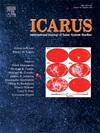探索海洋世界岩石圈缩短的不同构造表现:土卫二和木卫二
IF 2.5
2区 物理与天体物理
Q2 ASTRONOMY & ASTROPHYSICS
引用次数: 0
摘要
木卫二和土卫二都有数十公里厚的水冰壳覆盖着全球海洋。这两颗卫星都受到潮汐加热,相对于它们系统中的其他卫星,它们的岩石质量分数都很高,而且它们都有年轻的、构造变形的表面。尽管这两颗卫星有许多共同点,但它们的表面几乎没有相似之处。木卫二的构造以伸展特征为主,包括宽带,这意味着极大的表面应变。这种伸展所必需的岩石圈缩短所形成的特征在很大程度上是不存在的,但是在某些地方可能发生了长波褶皱。土卫二的构造包括伸展和收缩形成的特征。与木卫二不同,那里有大量褶皱、褶皱和逆冲带以及孤立的逆冲断层。在这项研究中,我们使用冰岩石圈缩短的数值模拟来对为什么两个有如此多共同点的卫星看起来彼此如此不同有新的见解。我们发现岩石圈的温度结构控制着由缩短引起的变形类型。由于较高的表面温度和热流导致的温暖条件产生折叠,这本质上是对缩短的粘性响应。较低的地表温度和热通量导致的低温导致断裂,这是一种脆性响应。中间条件可导致褶皱和断裂的复杂组合。我们假设,木卫二的表面通常足够温暖,可以通过细微的褶皱进行缩短,而这些褶皱在目前可用的稀疏地形数据中很难探测到,而土卫二的温度较低,有利于褶皱和断层的结合。我们认为构造风格对岩石圈温度的依赖自一致地解释了土卫二上观测到的构造模式,我们强调非刚性变形(褶皱)与木卫二上新兴的板块构造模式并不矛盾。本文章由计算机程序翻译,如有差异,请以英文原文为准。
Exploring the disparate tectonic manifestations of lithospheric shortening on ocean worlds: Enceladus and Europa
The moons Europa and Enceladus both have water-ice dominated shells tens of kilometers thick overlying global oceans. Both moons are tidally heated and have high rock mass-fractions relative to other moons in their system, and both have youthful, tectonically deformed surfaces. Despite their many commonalities, the surfaces of the two moons bear little resemblance to one another. Europa's tectonics are dominated by extensional features, including wide bands that imply extremely large surface strains. Features formed by the requisite lithospheric shortening accompanying such extension are largely absent, but long-wavelength folding may have occurred in some locations. Enceladus' tectonics include features formed in both extension and contraction. Unlike Europa, folds, fold and thrust belts, and isolated thrust faults are plentiful there. In this investigation we use numerical simulations of the shortening of ice lithospheres to bring new insight into why two moons with so much in common appear so different from each other. We find that the temperature structure of the lithosphere controls the style of deformation that results from shortening. Warm conditions resulting from higher surface temperatures and heat fluxes produce folding, which is essentially a viscous response to shortening. Cold temperatures resulting from lower surface temperatures and heat fluxes results in faulting, which is a brittle response. Intermediate conditions can lead to complex combinations of folding and faulting. We hypothesize that Europa's surface is generally warm enough for shortening to be accommodated by subtle folds that are difficult to detect in the sparse topography data currently available, whereas Enceladus' colder temperatures favor a combination of folding and faulting. We argue that the dependence of tectonic style on lithospheric temperature self-consistently explains the pattern of tectonics observed across Enceladus, and we emphasize that non-rigid deformation (folding) is not inconsistent with the emerging paradigm of plate tectonics on Europa.
求助全文
通过发布文献求助,成功后即可免费获取论文全文。
去求助
来源期刊

Icarus
地学天文-天文与天体物理
CiteScore
6.30
自引率
18.80%
发文量
356
审稿时长
2-4 weeks
期刊介绍:
Icarus is devoted to the publication of original contributions in the field of Solar System studies. Manuscripts reporting the results of new research - observational, experimental, or theoretical - concerning the astronomy, geology, meteorology, physics, chemistry, biology, and other scientific aspects of our Solar System or extrasolar systems are welcome. The journal generally does not publish papers devoted exclusively to the Sun, the Earth, celestial mechanics, meteoritics, or astrophysics. Icarus does not publish papers that provide "improved" versions of Bode''s law, or other numerical relations, without a sound physical basis. Icarus does not publish meeting announcements or general notices. Reviews, historical papers, and manuscripts describing spacecraft instrumentation may be considered, but only with prior approval of the editor. An entire issue of the journal is occasionally devoted to a single subject, usually arising from a conference on the same topic. The language of publication is English. American or British usage is accepted, but not a mixture of these.
 求助内容:
求助内容: 应助结果提醒方式:
应助结果提醒方式:


